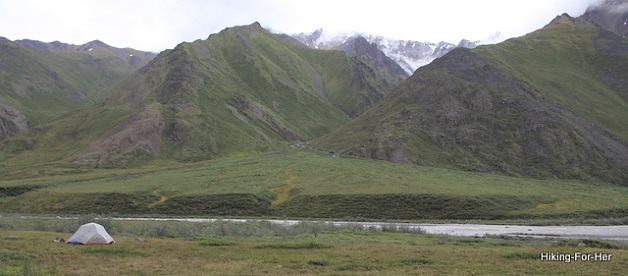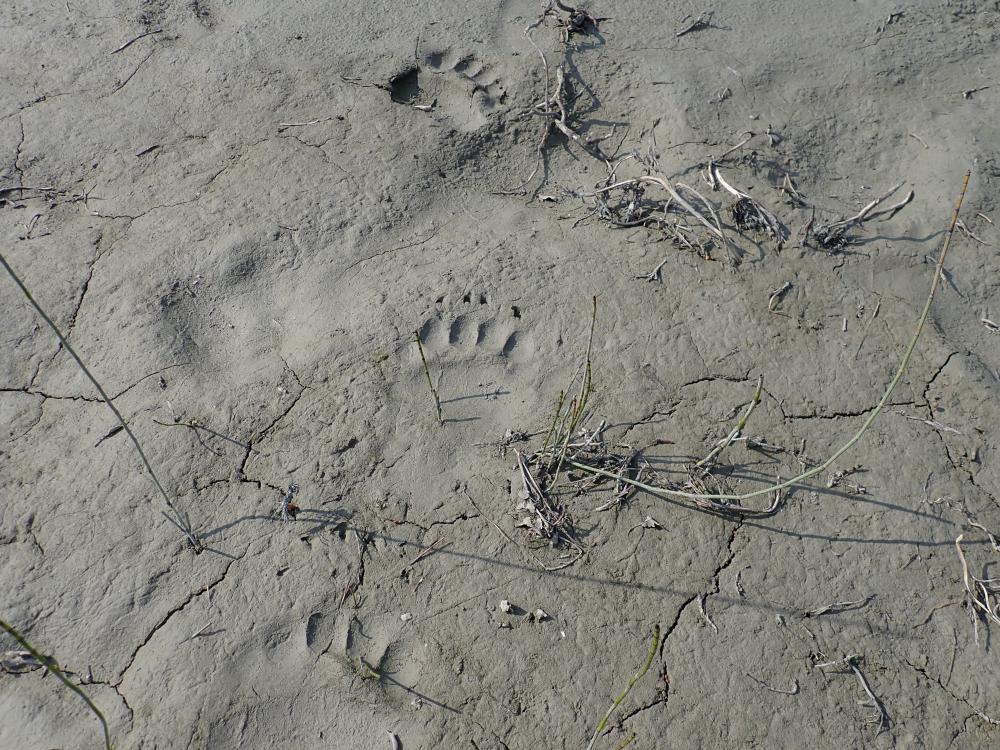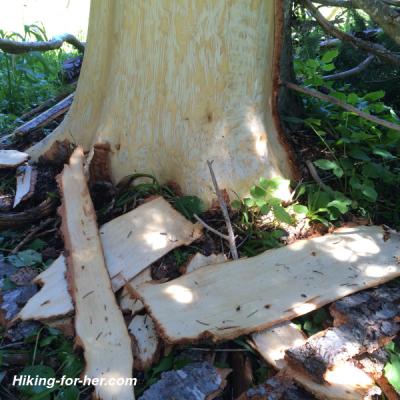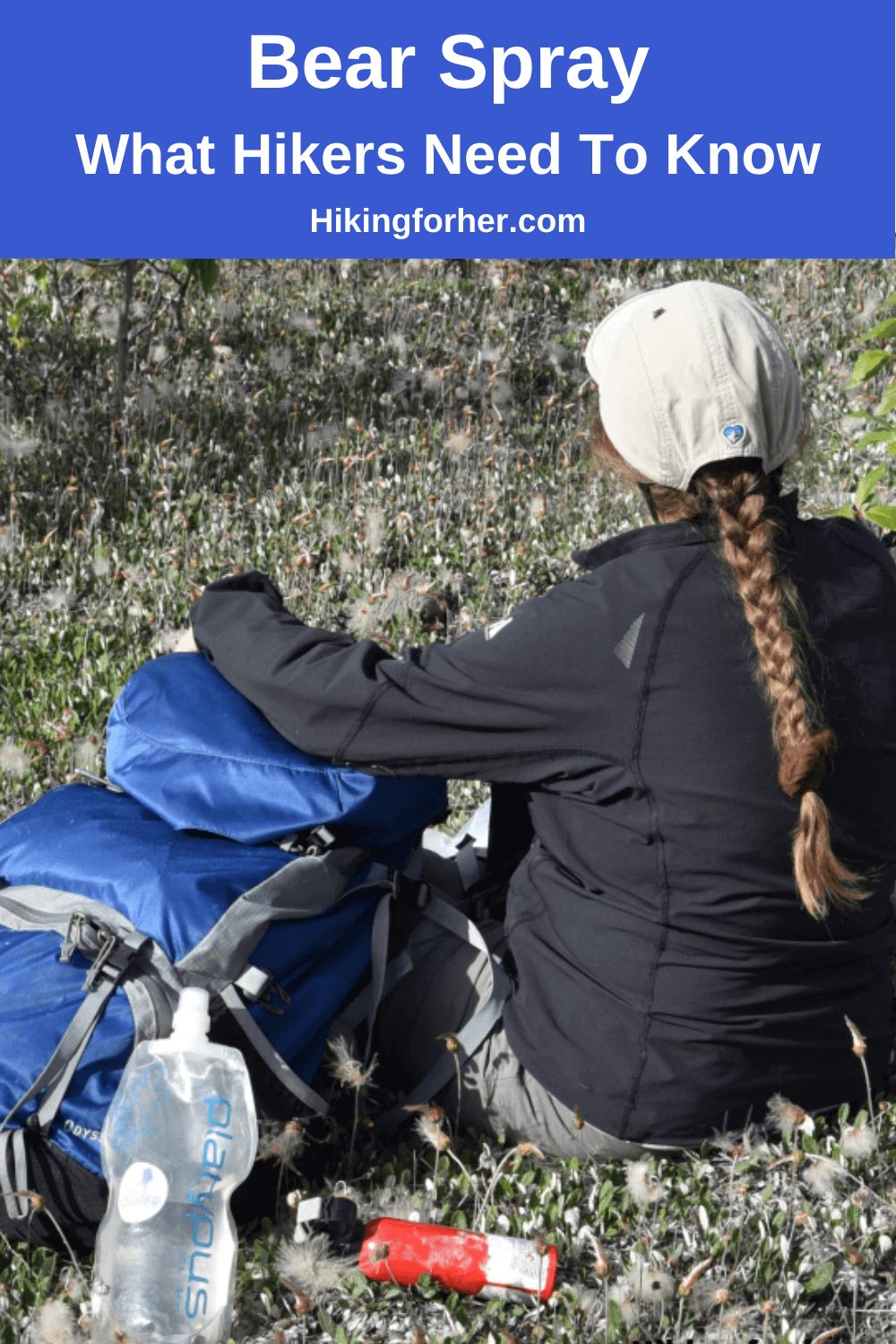
Bear Spray:
All You Need To Know
As A Hiker
By Diane Spicer
Bear spray: when to use it, and how to use it, are two things every backpacker in brown (grizzly) bear country needs to know.
I have no photos of brown bears to share with you on this page.
That is a very, very good thing.
It means that I've succeeded in keeping a clean backcountry camp, reducing food and garbage odors by using appropriate bear canisters, and thus I've never had a close call with Ursus horribilus/arctos.
Or I'm very lucky.
Either way, Amen!
However, I have plenty of photos of grizzly habitat, because I spend a lot of time there.

So I've taken it as a solemn duty to learn all that I can about brown bears, and to know how to keep myself as safe as possible on backcountry trips using bear deterrent strategies.
Let me share a few tips on how to do that, including the use of a pepper spray specially formulated to deter brown bears in a bad mood.
When to carry bear spray
If you know you're in brown bear country, you should be carrying bear spray as a bear deterrent.
Defensive spraying has been shown to be very effective at turning away a charging bear.
How do you know you're in grizzly terrain?
- Read the information compiled by the Interagency Grizzly Bear Committee (no joke).
- Parks Canada will let you know where their bears are.
- U.S. Fish and Wildlife Service has plenty to say about grizzly bears, too.
If you're planning to hike and backpack in these areas, you need bear deterrents which are non-toxic and most likely to work.
That's bear spray as personal defense, for most of us.
Each hiker in your group should have her own canister of spray like this one, and be knowledgeable about its use.
- Buy bear spray which contains 1.3-2% capsaicin and related capsaicinoids
- Watch the expiration date, and switch it out when it passes.
When to use bear spray
Your goal in carrying this little canister of unpleasantness is to never have to use it!
However, carrying bear spray may lead to overconfidence and complacency in the backcountry.
Vigilance is required.
Be very careful not to put yourself into a situation where the bear cannot see or hear you.
Examples of behavior to avoid in bear country
- Napping under a tree along rushing surface water
- Hiking silently through dense brush or near noisy water features
- Coming around blind corners on the trail without making noise
- Going off by yourself without telling your trail buddies what you're up to
- Making a trip into the bushes to do your business without scouting the area first
- Hiking in early morning or late evening when the bear is most likely to be going about its business: eating (although they tend to wander and graze at all times of the day)
Watch for bear signs
It's your job to remain "bear aware" at all times.
Keep your eyes peeled for bear scat, which are big lumps of you-know-what filled with berries, grass, hair and other signs that the bear is feeding in your area.
Also watch for bear tracks in the mud around streams and springs.
 Watch for bear activity between surface water sources
Watch for bear activity between surface water sourcesLong vertical scratches on trees and/or freshly stripped bark with weeping sap mean a large predator with sharp nails or claws is in the area.
 A bear used sharp claws recently on this tree
A bear used sharp claws recently on this tree
More good ways to be bear aware
- Spot their "beds", areas of flattened vegetation where they rest and sleep.
- Watch for their food caches: large humps of dirt covered carcasses. Don't linger there.
- Take note of dug up patches of stream banks, ant hills, and other areas where they can find insects, roots and other food.
- Really big rocks that are flipped over are a good bear sign, and a lesson in the power of a bear's claws.
Why would a human hiker waste time and energy doing that? Bears do!
And it goes without saying, don't go anywhere without your bear spray.
It won't do you any good if it's buried in your backpack, left in your tent while you take a bath in the river, or forgotten in your jacket thrown over a bush while you're napping in the sunshine.
The spray goes wherever you are: into the tent at night, especially.
Tip:
Every hiker in a group needs to carry a can of bear spray 24/7.
- Don't depend on someone else being there when you spot a bear.
Don't spray right away
When you spot a grizzly, you should be prepared to use the spray.
It should be on the outside of your backpack, within easy reach, or on your belt.
But don't prepare to use it immediately, unless the bear charges you.
- This can happen when mama bear realizes you are too close to her cubs.
- It may also happen when you startle a bear near running water or around a blind curve in the trail.
A bear charge can happen lightning fast, and you might not have time to react with your bear spray.
- Instead, protect your head and neck with your hands, and roll into a ball to protect your vital organs. Lie motionless.
Body language is your clue
about when - or if - to spray
Bears use body language just like people do.
If the bear is still sizing you up (take that literally), you might have some leeway to "read" its intent.
- Bears communicate their intent to threaten and intimidate you by making weird noises with their jaws and throat (like snorting and clacking teeth together).
- They may growl and slap the ground with their paws.
- They also may salivate, which will highlight their teeth and accentuate their role as a predator.
- Along the same lines, they position their bodies side ways to appear as large and threatening to you as possible. (This works remarkably well.)
As they are doing this, get your bear spray out of its holster or chest harness, and have it positioned in your hand so you can deploy it without having to look at it.
- You should have practiced this maneuver at home several times, to get the feel for it without looking.
Your instinct as a small soft creature is to run, or at least get away from that posturing bear.
But in your own best interest it's important to look big and threatening, and definitely not like prey.
Use your own body language
to send a message
You want the bear to know that you are not edible and certainly not weak or intimidated (fake it til you make it time).
Use your own body language to send a message which is the opposite of prey behavior:
- Sing loudly and off key.
- Wave your arms.
- Do. Not. Run. Bad things happen to humans who run from large mammals (cougars included)
You are signaling to this bear that you are a human, and therefore not on the menu.
If the bear comes in for a closer look,
what can you do?
If the bear approaches you once it spots you, it means one of two things, either curiosity or animosity toward you.
Curiosity can be handled by waiting things out, backing away slowly while talking to the bear, and remaining calm. Once the bear gets a good whiff of "essence of hiker", it may move away.
Animosity is nerve wracking, because you can never be sure what the bear intends to do. You've created an upset in its routine, and it's not happy about you being there.
- Give this magnificent creature with the big teeth and claws plenty of space and room to beat a hasty exit.
- Don't make sudden moves that could provoke a reaction, but get your hands on your bear spray.
- Stay on high alert for the next signal from the bear.
Maybe the message is just to intimidate you
There is a possibility of bluff charging, when the bear runs at you full speed but diverts at the last possible moment.
You won't know if it's a bluff or for real, so once the bear is within 20 feet (6 m), it's time to introduce it to your friend, Bear Spray.
Spray being the operative word.
Even when your hands are shaking.
How to use bear spray
Let's back up even further, to when you purchased the bear spray.
The spray can was sold with a zip tie or some other way to lock the safety clip.
- Be sure that extra step of protection is long gone before you are in a situation where you need to use the spray.
Build muscle memory with practice
This probably sounds silly as you're sitting in comfort reading this, but you should practice the sequence described below until you can use it without looking at it.
- Build a kinesthetic sense of how your hand feels holding it, the weight and dimensions of the canister, and where the release for the safety clip is located.
You can't even believe how scared you'll be when you see a brown bear coming your way, so train your muscles to react even when your mind is screeching pitiful little sentences about running away.
Here's how to deploy the spray
The spray is only effective if it contacts the mucous membranes of your ursine friend.
So let's make sure that it does.
Imagine that the bear is close to you, and facing toward you.
- Use both hands to release a 3 - 6 second burst of spray.
- Then release another one.
Aim a bit low.
You want to create a mist that will rise up and get the bear's attention as it comes even closer.
It would be great if you were upwind of the noxious spray, but you won't have time to make that particular calculation unless you already did while sizing up the bear's behavior (see tip below).
Don't drop the can and run. This will be incredibly hard to achieve, but do not run.
You are hoping for a total yet temporary loss of the bear's ability to continue its attack.
Don't turn your back on the bear, because you need to see how it reacts.
It should move away from you, reacting to the painful sensation of pepper spray in its face.
As the bear begins to leave the area, walk backwards slowly and monitor its actions.
You don't want a repeat attack or counter assault to catch you off guard.
Watch this video for a good demonstration of how to use bear spray.
Tip:
If you have the presence of mind when you meet a bear on a windy day, you can do a test blast (1 second or less) of your canister just to get a sense of where the spray will be carried.
You want it to hit the bear's face (downwind), not yours (upwind).
- Do this before the bear comes into range.
Report the encounter
It's up to you whether or not to tell the local authorities about your run in with a bear.
Filing a report becomes important when the bear's behavior is aggressive and you want to warn other hikers and campers.
It also helps law enforcement and emergency responders put together a pattern in order to locate a rogue bear.
- Sometimes trails have to be closed when bear activity is extreme, as happens each summer in Yellowstone National Park.
This protects bears, and people.
Side effects of using bear spray
What's bad for the bear's mucous membranes is also horrible for yours.
If a breeze brings some of the irritating vapors into your face, your eyes and nose will run and sting like crazy.
You might have temporary restriction of breathing, temporary restriction of sight, and you will be a lot of discomfort, some might call it pain.
Your only consolation: If it reached the bear's face, that's what's happening in Bear-ville, too.
Storing your bear spray
To maximize its effectiveness, there are a few things you should do with the spray canister:
Store it in reasonable temperatures to extend shelf life
- Don't store the canister near heat sources at home, such as a shelf next to the furnace or a large south facing picture window.
Never bring the spray into the passenger compartment of the car without a heavy storage container.
The expiration date is firm, and generous at around 4 years. Once the date has passed, get a new bear spray.
- You don't want to rely upon the false hope of bear spray that has lost its effectiveness, do you?
Traveling with bear spray
It would be a very bad thing if a can of bear spray exploded inside an airplane or other enclosed space, right?
For this reason, you must check the regulations when you fly to a hiking destination.
Bush pilots will duct tape the bear spray to the outside struts (be sure to take it off at your destination, or risk watching your bear deterrent taxi away and go bye-bye).
Helicopter pilots will store the bear spray in the aft cargo compartment, where it has reduced chance of contacting your mucus membranes if it explodes.
If you're traveling via train or bus, be sure you understand how to segregate and protect your bear spray.
What experts say about
efficacy of bear spray
I'm not a bear expert, so all I can do is rely upon the expertise and wisdom of those who are looking at data or working in bear country for long periods of time.
Like me, you can learn from the results of a study which looked at a sample of bear spray incidents in Alaska over the years 1985 to 2006.
Update: The study's pdf has been removed from the Washington Department of Fish and Wildlife website so I can no longer provide the link to it, but I was lucky enough to read it before it disappeared.
Its conclusion:
- Bear spray makes sense as a personal bear deterrent, and can be used as an alternative to lethal force (carrying a gun).
Dive even deeper into how to
hike among bears
This book, Hiking in Grizzly Country: Lessons Learned and Shared by Tim Rubbert gives you even more information to work with if you're going into bear territory.
Summing it up:
be smart and prepared
Isn't it nice to know that the chances of a bear encounter go way, way down if you know how to handle brown bear territory?
First line of defense against a bear attack:
- Know when you're in bear territory.
Second line:
- Remain bear aware.
Third line:
- Avoid confrontation by understanding bear body language.
- Read a few books.
Fourth line:
- Buy bear spray and use it correctly as your final line of bear safety.
Thrilling, or chilling?
To be honest, the thrill of seeing these huge creatures is one that will stay with you for the rest of your life.
- I had the privilege of seeing one on the shore of the Canning River in the Arctic National Wildlife Refuge.
- And lots more, on a trip down the Alsek River (Yukon to Alaska, largest concentration of brown bears anywhere)
Sounds like a thrill you'd rather skip?
Here's the hard truth:
Sometimes you have no choice. Bears may live where you want to hike.
Just handle the encounter in the best way possible, which you now know how to do.
Home page > Best Hiking Tips >
Using Bear Spray
|
I get emails all the time about what I wear, eat, carry and love to use on the trail. That's
why I provide affiliate links to you: the best gear that I use myself and have seen used by other hikers is instantly
available for your consideration, and the gear company sends a few
pennies per dollar to this reader-supported hiking website. There is no added cost to you! Everyone ends up a winner: Great gear for you, strong gear companies, and more free hiking tips for everyone. Thanks very much for your support. It's warmly and sincerely appreciated. It also helps send these hiking tips to all your virtual trail buddies around the globe. |
 |



